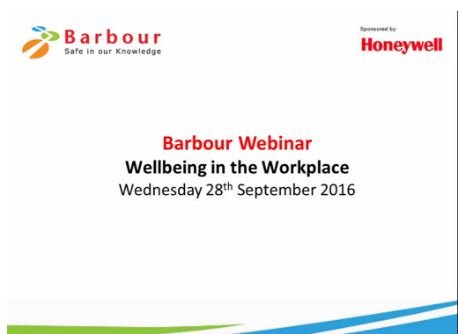A webinar, hosted by Barbour EHS, at the end of September saw Karl Simons, head of health and safety at Thames Water and Clive Johnson, head of health, safety and security at Land Securities, talked through their approaches to wellbeing within an occupational health programme and how and why wellbeing should be successfully integrated into your organisation.
Lots of questions were put to the speakers throughout the presentation, and here they take the time to answer some of them. Re-watch the wellbeing webinar now.
Is reducing the levels of stress showing any improvements in the last few years? Stress is a killer and I am not convinced it is being addressed properly. Is it thought that the suicides in construction are stress related?
Clive Johnson: I think we are only just waking up to it and just scratching the surface of this problem, we need to get rid of the stigma associated with Mental Health/Stress. we have to create a culture when its accepted to talk about it. We at LS have now created such a culture a programme in place now to address this within the business with training for all levels.
In the case of a primary contractor where a subcontractor is employed, who would take responsibility for health of contractors?
Karl Simons: Any employer regardless of size is responsible for the health and safety of their employees. The Principal Contractor has a responsibility to vet and appoint competent organisations to undertake work on their behalf and can have a significant affect on a sub-contractor through outlining their expectations regarding health and wellbeing standards within their contractual documents
One of my challenges is getting Executives and Management to understand the benefits of and reasons for Wellness management in the workplace.How does one change the culture from top down?
CJ: Selling wellness/wellbeing management to the execs and senior management is the same business case as safety and the return on investment is clear with energised staff reduced sickness to name just a few.
In terms of cost, how much resource have you involved in driving and introducing health incentives?
KS: Many of the initiatives introduced cost very little and often the commencement of a good occupational health programme is driven by a handful of committed specialist individuals that quickly becomes owned by the operational managers.
How are Thames Water and Land Securities contractors and sub contractors buying into this ? Is it a prerequisite selection and or tender requirement ?
CJ: At Land Securities we have an Occupational Health Customer Improvement Group where all our contractors and service partners Occupational Health Managers get together every quarter to agree a Occupational Health Charter and implement the actions.
For example, in our tender all our projects over a six-week duration need to sign up to an Occupational Health Scheme. The HCLG is now also driving the health agenda, see the website for BP case studies, or even better become a partner.
Have you ever recorded any improvement in performance, lower employee absence, etc as a direct result of health and wellbeing intervention?
KS: We have numerous examples of how targeted intervention has had an affect within the business. Recently we developed a physiotherapy based health intervention amongst a group of operational workers. This was coupled with a new manual handling programme. Within six months absence related to MSDs in this group reduced from 200 days/17 cases per month to 87 days/7 cases.
What sort of resourcing from health and safety teams do you need to put some of the wonderful initiatives in place?
CJ: I am upskilling my team on the health front so their health knowledge will be aligned with the safety knowledge. We’ve got them on the NEBOSH Occupational Health course (one week), they have completed the Mental Health First Aid training, and when it’s launched the new BOHS Course for health and safety managers, etc. We also found that internal messaging via the intranet was very successful in raising the health profile and making it easier to talk about it.
Do you include CSR (corporate social responsibility) into your wellbeing programmes? If so how?
KS: We believe we should be encouraging wellbeing not only in our own employees but those in the wider community that we come into contact with. We will strive to deliver initiatives that impact families and friends, other organisations’ employees and other interested parties. we have many tangible examples through feedback of how our personal Medical assessments have enabled lifestyle changes to be made at home by families where concerns are raised to individuals about their own condition.
How does Land Securities believe we can best extend ‘wellbeing in the workplace’ to contractor staff that do not work in offices; such as security and cleaning teams?
CJ: We are currently doing this via our Customer Improvement Group of which include cleaning, security and contractors.
What do we really mean by ‘well being’ and how is it different to mental health and psychological health in the workplace?
KS: Wellbeing should include both positive mental and physical health as well as positive behaviour change.
Do you find you get any reluctance from any employees who do not want to participate in health surveillance? If so how do you deal with this to encourage them to participate?
KS: The vast majority of employees are keen to participate in health surveillance.on occasion some people miss appointments but this is usually due to ‘forgetfulness’ rather than a reluctance to engage. Managers have control and support this which helps.
What is a ‘Fit Build’ building please?
CJ: The Well Building Standard version 1 marries best practice in design and construction. It harnesses the built environment as a vehicle to support human health,well-being and comfort WELL Certified spaces and developments can lead to a built environment that helps to improve the nutrition, fitness, mood sleep , comfort and performance of its occupants. Thus designed to encourage healthier and more active lifestyle and reducing occupational exposure to harmful chemicals and pollutants.
Has there been a decrease in absence rates since focus on wellbeing has increased?
KS: In key areas there has been a noticeable reductions in absence rates, particularly if the wellbeing focus has been specific to the nature of the work in these areas. Targeted intervention based on RIS will make a difference as it will be bespoke to the group of people or work undertaken by the individuals.
Register for the next Barbour webinar, taking place on 28th October on the latest health and safety legislation and guidance update.
SHP Webinars
Find upcoming live, interactive webinars plus on-demand sessions to watch back at your convenience.
SHP runs regular health and safety webinars on a wide range of topics, from high level thought leadership, to legislation updates and technical guidance.
Click below to see what’s coming up and what you can watch right now...


